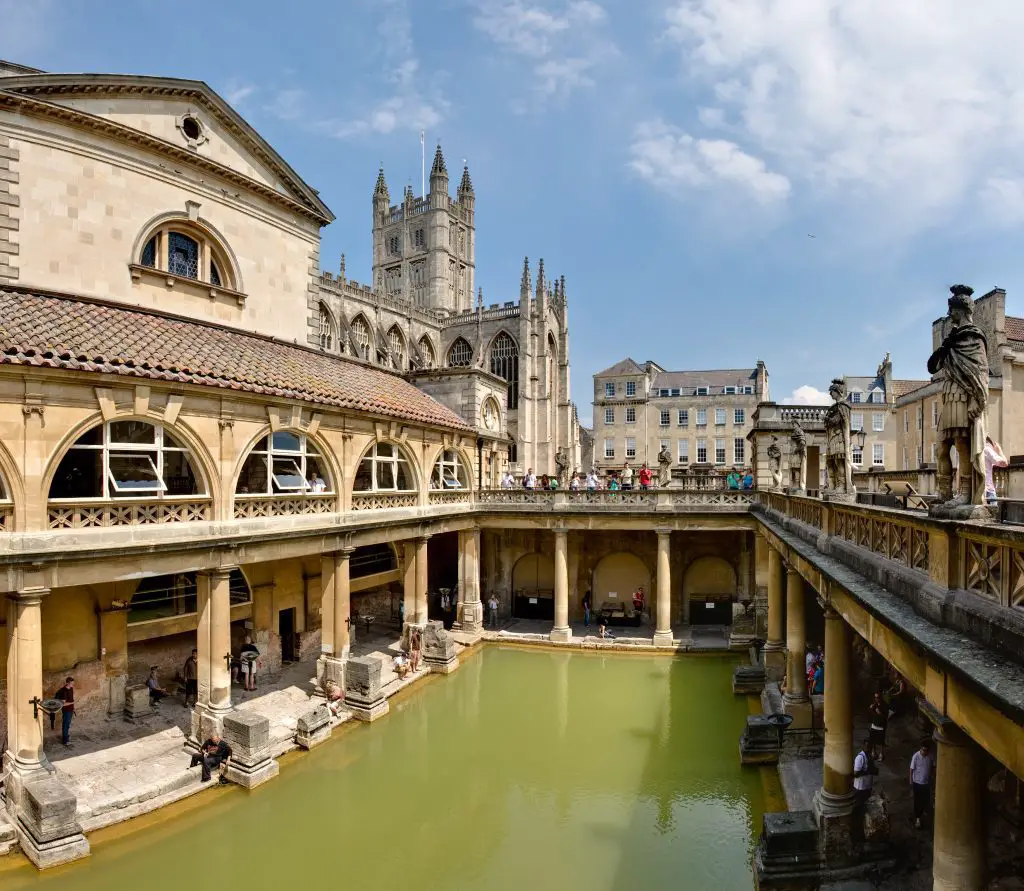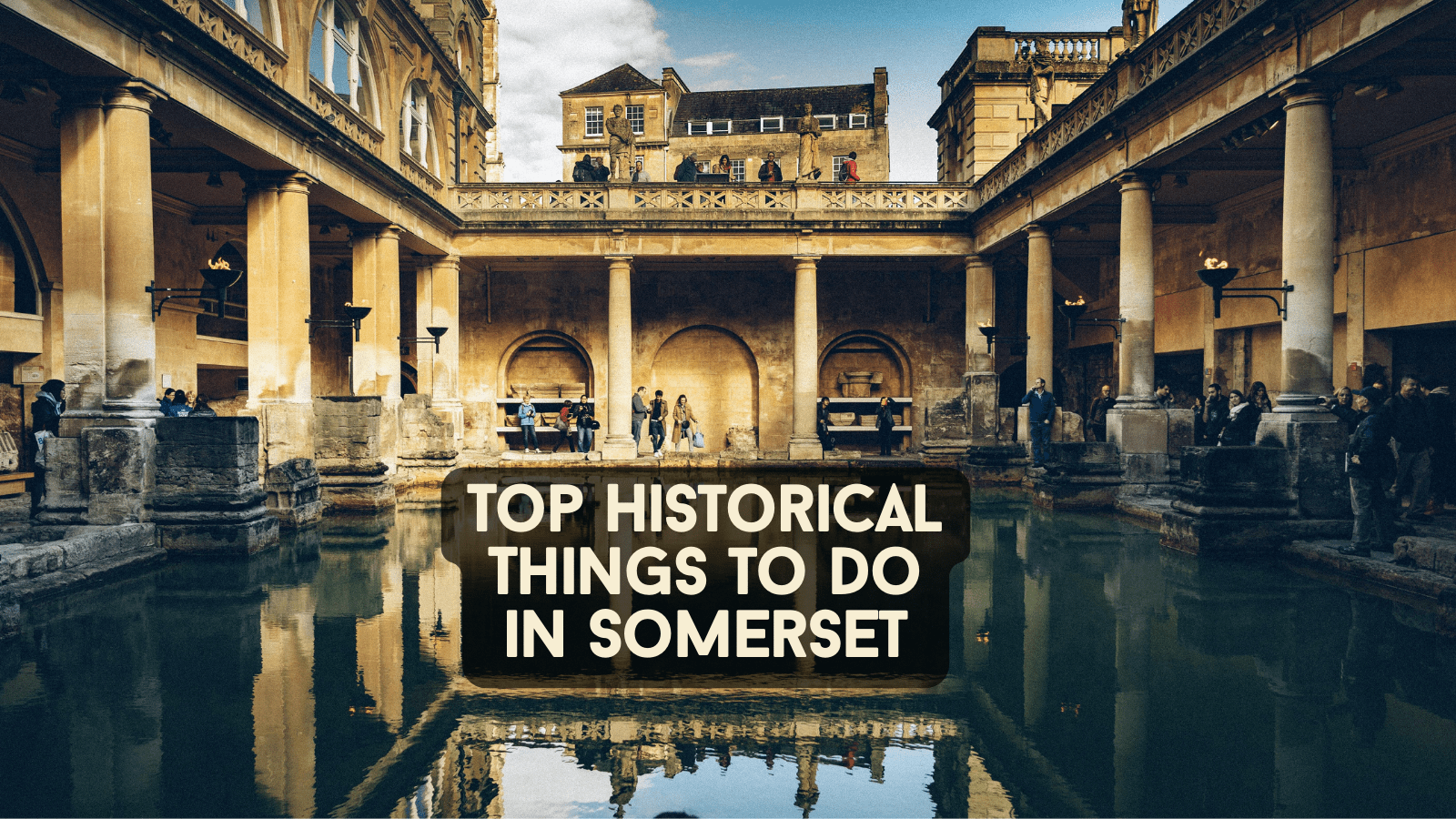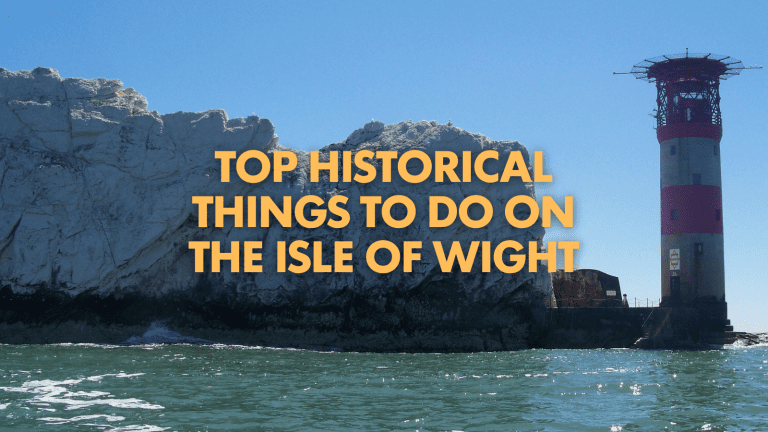Top 23 Historical Things to do in Somerset in 2024
Somerset featured in a pronounced way during King Henry’s dissolution of the monasteries in the 1530s. The lands of the monasteries that were dissolved were bought by certain important families in Somerset from the king.
Somerset is well respected for its cider and cheddar cheese. Somerset was once the cider capital of the UK thanks to its treasure of apple orchards. Today, the Cheddar Gorge caves are still in use for the maturation of cheese.
Cheddar Palace
The Royal Palace at Cheddar has stood since the 10th century, gaining a licence to crenellate in 1264. Three chapels stood on this site, replacing 10th and 11th-century buildings. The third chapel, dedicated to St Columbanus, lies in ruins, having survived from around 1300. The 17th century saw the chapel converted into a house, existing as such until a century ago.
Toilets: No
Car Park: No
Walking: Yes
Dog Friendly: Yes
Kids Playground: Yes
Cafe / Restaurant: No
Barrington Court
Henry Daubeney inherited Barrington Court from his father who was a courtier to Henry VII in 1514. Henry Daubeney and Henry VIII’s doomed wives Anne Boleyn and Catherine Howard were related through marriage. Daubney was made the first Earl of Bridgwater by Henry VIII.
In the swinging 20s, Colonel Arthur Lyle rescued the dilapidated 16th-century Court House to restore it to its former glory and revive the productive estate. He made his money out of the colonial sugar industry to become the Director of his grandfather’s company, now known as Tate & Lyle. His restored house was filled with architectural salvage he had salvaged as well as rescued staircases, panelling, and fireplaces.
Gertrude Jekyll influenced the walled White Garden, Rose and Iris Garden, and Lily Garden with their playing fountains, brilliant hues, and heady perfumes. The original kitchen garden keeps the kitchen stocked. This self-sufficient Lyle family hosts events teaching those who are willing to camp, climb trees, and build bird boxes.
National Trust
Toilets: Yes
Car Park: Yes
Walking: Yes
Dog Friendly: Yes
Kids Playground: Yes
Cafe / Restaurant: Yes

copyright martinvl https://creativecommons.org/licenses/by-sa/4.0/
Tyntesfield
The extravagant Neo-Gothic house of Tyntesfield was built for the merchant, William Gibbs, who profitably traded with Spain and South America. The Estate was named Tyntes Place when William Gibbs acquired it in 1843. Remodelling started in 1863, converting the existing Georgian house according to Gothic Revival principles. The house symbolised the owner’s Anglo-Catholicism. Amidst the woodland play area, plants, trees, and wildlife, events such as guided estate walks, woodwork classes, outdoor theatre events, and sketching tours are hosted on the estate.
National Trust
Toilets: Yes
Car Park: Yes
Walking: Yes
Dog Friendly: Yes
Kids Playground: Yes
Cafe / Restaurant: Yes
The Roman Baths, Bath
Somerset boasts Britain’s only hot spring and it was on this site that the Romans built their splendid temple and bathing complex. After 2000 years, the hot waters still flow from their natural source. Visitors can see the ruins of the temple of Minerva that attracted Roman worshippers thousands of years ago.
The museum teaches us about the people who lived and loved in a time before us through such inspirations as the costumed characters who revive the stories of yesteryear’s people. The display included the Beau Street Hoard which is a collection of over 17,000 Roman coins recently discovered on Beau Street in Bath.
Take a break in the 18th-century Pump Room for a lunch or afternoon tea accompanied by live music.
Toilets: Yes
Car Park: No
Walking: No
Dog Friendly: No
Kids Playground: No
Cafe / Restaurant: Yes

https://creativecommons.org/licenses/by-sa/3.0/deed.en. copyright Diliff
Bath Abbey
A church has stood on this site in three different forms since 757 AD. The first was the Anglo-Saxon monastery razed by the Norman conquerors. They replaced it with their massive Norman cathedral around 1090, which was also reverted to ruins by the late 1400s. It was in the years following that the present-day Abbey church took its place here.
Bath Abbey boasts the unique ladders of angels said to have come to be because the Bishop of Bath, Oliver King, dreamt of angels ascending and descending into heaven. It was this dream that inspired not only this design but the new abbey church in its entirety. The church lived on to be the last great medieval cathedral built in England.
The dissolution of the monasteries ordered by King Henry VIII in 1539 saw the abbey laid to ruin for over 70 years. In 1616, restorations began to restore it to use as a parish church. In the 1830s, after another two hundred years, local architect George Manners added new pinnacles and flying buttresses to the exterior and interior. He also built a new organ and galleries over the choir and installed extra seating.
Between 1864 and 1874, Sir George Gilbert Scott transformed the interior according to his vision of Victorian Gothic architecture. Replacing the ancient wooden ceiling over the nave with the spectacular stone fan vaulting still there today is indubitably his greatest work.
A National Churches Trust initiative.
Toilets: No
Car Park: Yes
Walking: No
Dog Friendly: No
Kids Playground: No
Cafe / Restaurant: No
Glastonbury Abbey
Rife with legend and myth since Medieval times, Glastonbury Abbey is lauded as the earliest Christian foundation in Britain linked to Joseph of Arimathea and the burial place of King Arthur. It is a tourist attraction as much for its history and folklore as its spiritual enrichment, being that a church has occupied the site for more than 1500 years. By the end of the medieval age, Glastonbury was second only to Westminster as the richest monastery in England.
A National Church Trust initiative.
Toilets: Yes
Car Park: Yes
Walking: Yes
Dog Friendly: Yes
Kids Playground: Yes
Cafe / Restaurant: Yes
Wells Cathedral
Befitting its description as “the most poetic of the English Cathedrals”, Wells Cathedral was built between 1175 and 1490, the first English Cathedral built in the Gothic style. It stands out among other English cathedrals by its iconic West Front and the ‘scissor arches’ that support the central tower. Not to be discounted is its standing as boasting one of the largest collections of historic stained glass in the country. Its Wells Clock is believed to be the second oldest clock mechanism in Great Britain. Visitors can tour the cathedral for free every day except Sunday throughout the year.
Toilets: Yes
Car Park: No
Walking: No
Dog Friendly: No
Kids Playground: No
Cafe / Restaurant: Yes
Shepton Mallet Prison
King James introduced the act for all counties to have their own ‘House of Correction’. Soon after, Shepton Mallet was built in 1610 to be the oldest working prison in the United Kingdom, opening in 1646. The Georgian jail was decommissioned in 2013, and its life as a category C lifer prison holding 189 prisoners came to an end. In 1930, the prison closed due to low numbers of inmates, but it returned as a military prison after WW2 broke out. A new execution block was added to hang condemned prisoners. Important historical documents were stored here, among them the Domesday Book. The prison returned to civilian use in 1966.
It is now open to the public with guided tours, self-guided tours, ghost tours, A Night Behind Bars, escape rooms, and Prison Break.
Toilets: Yes
Car Park: Yes
Walking: Yes
Dog Friendly: Yes
Kids Playground: No
Cafe / Restaurant: Yes
Priddy
The Mendip village of Priddy saw the excavation of a Mesolithic hut site in 1977. But Priddy had relics of yesteryear found long before this. The Priddy Circles, a Stone circle or Henge monument of the same Neolithic era – circa 2180 BC – as the more famous Wiltshire Stonehenge, are nearby. Priddy’s Neolithic ‘Henges’ was, however, made of wood. Neighbours to the Circles on the North Hill are two round barrow cemeteries, Ashen Hill and Priddy Nine-Barrows. Priddy’s ‘Nine Barrows’ inspired the legend that a golden coffin was buried in one of them. Signs of the Bronze age are evident at Deer Leap in the form of a burial mound. Remnants of a medieval settlement of Ramspit share this location, and the Neolithic ceremonial location of Drove Cottage Henge lies east of the village.
Toilets: No
Car Park: No
Walking: Yes
Dog Friendly: No
Kids Playground: No
Cafe / Restaurant: Yes
King John’s Hunting Lodge
King John’s Hunting Lodge is open to the public as a local history museum at a fee. It is an early Tudor timber-framed wool merchant’s house from around 1500 and is a fine specimen of medieval life. Arcaded stalls open onto the street on the ground floor.
Toilets: No
Car Park: Yes
Walking: No
Dog Friendly: No
Kids Playground: No
Cafe / Restaurant: No
Old Hall Somerton
When Edward I arrived in Somerset on his way to Glastonbury in 1278, the Old Hall was set up as the County Hall and the Court of Assizes. Somerton qualified as such as head of the county.
Toilets: No
Car Park: No
Walking: Yes
Dog Friendly: No
Kids Playground: No
Cafe / Restaurant: No
Montacute House
Elizabethan Renaissance architecture and design at its finest, resplendent with towering walls of glass and ham stone, set as it is in its garden and parkland, is Montacute House. Built in 1601, it stood as a statement of wealth, ambition, and showmanship. It boasts the longest Long Gallery of its kind in England, displaying more than 60 Tudor and Elizabethan portraits on loan from the National Portrait Gallery. Montacute House plays host to outside theatres, archery, and wood art workshops.
National Trust
Toilets: Yes
Car Park: Yes
Walking: Yes
Dog Friendly: Yes
Kids Playground: Yes
Cafe / Restaurant: Yes
Ilminster Minster
Named after the church, the village mushroomed around it, as well as the River Ile that runs through it, and we have Ilminster Minster. The Minster church dates back to medieval times, around 1450. The churchyard is surrounded by the oldest buildings, such as the grammar school founded in 1549. During Victorian times, this was a staging post for travellers with east-west and north-south routes converging. The peaceful village, with its enchanting street names like Strawberry Bank, boasts a Market Square, a theatre, and interesting shops.
Toilets: Yes
Car Park: No
Walking: No
Dog Friendly: No
Kids Playground: No
Cafe / Restaurant: No
Taunton Castle
In the heart of Somerset’s county town stands Taunton Castle, which has housed a museum for well over a century now. The bishops of Winchester owned a great Somerset estate of which Taunton Castle was at the heart. This was their residence in the Anglo-Saxon period. Although they owned land over seven English counties, Taunton was their largest estate, spread over thousands of acres in the Vale of Taunton Deane.
In the 12th century, the castle served as an administrative centre and a status symbol, receiving such guests as King John and his son Henry III. The Yorkist, the Earl of Devon, was besieged at Taunton in 1451 by the Lancastrian Lord Bonville. The Castle sustained severe damage during three bitter sieges during the Civil War in 1644–5. In September 1685, the Bloody Assizes following the Monmouth Rebellion were presided over in the Castle’s Great Hall, where 144 rebels were sentenced to be hanged, drawn, and quartered. After serving as a law court until 1858, the Castle began falling into decay, only to be saved by the Somerset Archaeological and Natural History Society, which bought it in 1874. The result is the Museum of Somerset.
Toilets: Yes
Car Park: Yes
Walking: Yes
Dog Friendly: No
Kids Playground: No
Cafe / Restaurant: Yes
Longleat House
Offering 450 years of history, Longleat House is a fine example of high Elizabethan architecture. Today, this stately home, occupied by the 7th Marquess of Bath, is open to the public and has been home to 15 generations of the Thynne family. Set in 900 acres of ‘Capability’ Brown landscaped gardens, Longleat House was once a 16th-century Augustinian priory. The many treasures and heirlooms lovingly added by generations of the Thynne family comprise early books and manuscripts, paintings, Flemish tapestries, and fine French furniture.
Toilets: Yes
Car Park: Yes
Walking: Yes
Dog Friendly: No
Kids Playground: Yes
Cafe / Restaurant: Yes

Copyright Saffron Blaze https://creativecommons.org/licenses/by-sa/3.0/
Dunster Castle
Standing vigil dramatically from its wooded hill since Norman times, Dunster Castle’s medieval gatehouse and ruined tower speak of a turbulent past. The Luttrell family has lived in the castle for 600 years, succeeding in the 19th century in establishing it as a lavish country home. The terraced garden and tranquil riverside wooded garden below provide an opportunity to enjoy the grounds, with trails for walkers and lead to the historic working watermill. Visitors can tour the castle and attend events at the outdoor theatre.
National Trust
Toilets: Yes
Car Park: Yes
Walking: Yes
Dog Friendly: Yes
Kids Playground: Yes
Cafe / Restaurant: Yes

The Bishop’s Palace
In the early thirteenth century, the first Bishop of Bath and Wells received a crown licence to build a residence and deer park on land to the south of the Cathedral of St Andrew. The Bishop’s Palace is the result. The Bishop’s Palace and Gardens remain home to the Bishops of Bath and Wells for more than 800 years. The medieval palace, while still occupied as such, is open to the public, welcoming visitors to walk in their footsteps through many of the rooms of the Palace. Visitors get to cross the moat, watch the resident swans from the flagstone drawbridge and explore the 14 acres of RHS Partner gardens.
The palace hosts year-round family events, garden activity days, historic re-enactments, concerts, talks, workshops, demonstrations, family theatre, and guided tours. Visitors are invited to browse the gift shop and partake in the café, which offers the best views in all of Wells.
National Trust
Toilets: Yes
Car Park: No
Walking: Yes
Dog Friendly: Yes (Grounds Only)
Kids Playground: Yes
Cafe / Restaurant: Yes
Hestercombe House
Hestercombe is old, with a mention in an Anglo–Saxon charter of 682. Today, the stone archway circa 1280 is the earliest remaining medieval feature. This can be seen at the A Gentleman of Taste exhibition. Hestercombe House belonged to the Warre family between 1391 and 1872. Over this half-century, the house was much reinvented. Between 1725 and 1730 most of the medieval section of the house was removed, and the west elevation was re-fronted to the typical Georgian façade present today. In 1872, the 1st Viscount Portman took ownership and the house underwent an expensive Victorian facelift. A new wing was added in 1895 to the rear of the 17th-century Orangery. Today, the Stables Restaurant feeds the hungry where the stables, tack room, groom’s accommodation, and loose boxes once catered to the horses. 1904 saw the Formal Garden, designed by Edwin Lutyens, take form.
After housing the headquarters of Somerset Fire Brigade for over 60 years, the Hestercombe Gardens Trust from Somerset County Council acquired the property in 2013. The house was opened to the public in May 2014 with its gallery, gift shop, and second-hand book shop.
Toilets: Yes
Car Park: Yes
Walking: Yes
Dog Friendly: Yes
Kids Playground: Yes
Cafe / Restaurant: Yes
Somerset Rural Life Museum
To get a glimpse into the rural lives of the English countrymen from the 1800s onward, visit the Somerset Rural Life Museum. Learn about the county’s heritage, landscape, food and farming, working life, and rural crafts through the five Farmhouse Galleries and the large Farmyard Gallery. The centrepiece is the 14th-century Abbey Barn, which also plays host to exhibitions and events.
The Grain Store Café offers quality locally sourced food and drink.
Toilets: Yes
Car Park: Yes
Walking: No
Dog Friendly: No
Kids Playground: No
Cafe / Restaurant: Yes
Cadbury Castle
This military stronghold has stood since the Stone Age, a fort for over 4000 years. The Durotriges tribe occupied the fort during the Iron Age, falling to the invading Romans in AD 70, who then razed the fort and surrounding village. 16th-century legend held that King Arthur used the castle during the 6th century, and archaeological evidence suggests it to be an important fortification at that time. AD 500 saw the fort re-established and then extended by Ethelred the Unready in AD 1000. He used it to defend against the plundering Vikings.
Toilets: No
Car Park: No
Walking: Yes
Dog Friendly: Yes
Kids Playground: Yes
Cafe / Restaurant: No
Box Tunnel
Box Tunnel between Chippenham and Bath took the cake as the most difficult single engineering work on the route between London and Bristol. Critics debunked its proposal in the Great Western Railway Act of 1835 as an impossible and dangerous engineering project because of the unusually steep gradient, by Brunel’s standards, of 1 in 100 over its length. Completion ran long overdue, effectively completed in April 1841, months after the other sections of the London to Bristol route were done. Work on the tunnel was undertaken simultaneously from both the east and west sides of Box Hill in 1836. So on the mark were Brunel’s calculations, and so skilled were the contractors and navvies that when the two ends met in 1841, the alignment was out by less than 2 inches (5cm). It opened unceremoniously through London – Bristol traffic on 30 June 1841.
Toilets: No
Car Park: No
Walking: No
Dog Friendly: No
Kids Playground: No
Cafe / Restaurant: No
Fleet Air Museum
The Fleet Air Arm Museum in Yeovilton Somerset is where the Museum meets theatre. The largest collection of Naval aircraft in Europe is displayed here alongside the first British-built Concorde, the cockpit of which is open for viewing.
Visitors get to ‘fly’ by helicopter to the replica flight deck of the aircraft carrier HMS Ark Royal to bear witness to fighter aircraft, a Phantom interceptor fighter, and a Buccaneer strike bomber projected onto huge screens. An interactive experience not to be missed.
Toilets: Yes
Car Park: Yes
Walking: No
Dog Friendly: No
Kids Playground: Yes
Cafe / Restaurant: Yes
Haynes International Motor Museum
With the UK’s largest collection of the greatest cars, visitors to The Haynes International Motor Museum have more than 400 cars and bikes to see. Cars and bikes from the late 1800s through the 1950s and 1960s; there are Bentleys, Rolls Royces and supercars like the Jaguar XJ220.
Toilets: Yes
Car Park: Yes
Walking: Yes
Dog Friendly: Yes
Kids Playground: Yes
Cafe / Restaurant: Yes






